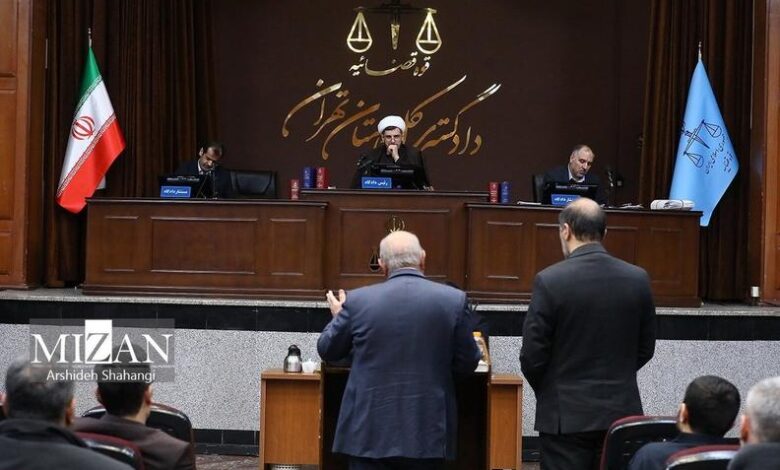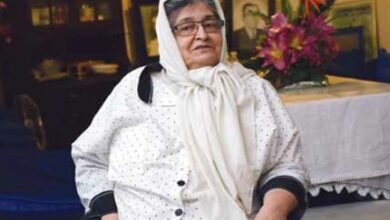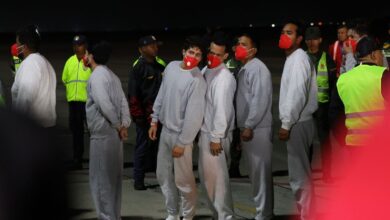27th Session of the Court Investigating the Charges of the MEK
Association for Defending Victims of Terrorism - The 27th court session, examining the charges against 104 members of the Mujahedin-e Khalq (MEK), as well as the organization’s nature as a legal entity, was held in public on Tuesday, January 21, in Branch 11 of the Criminal Court of Tehran Province, presided over by Judge Amirreza Dehghani and court advisors Morteza Turk and Amin Nasseri, Vaziri representing the prosecutor, the families of the victims and their lawyers, as well as the lawyers of the defendants.

The plaintiffs’ lawyer, Kazemi began his speech explaining the structures of criminal groups according to the science of law. He stated that the MEK should be considered a legal entity. Stating that criminal groups are illegal groups due to their criminal nature and the basis for the formation of these groups is to commit illegal acts, he said: “Therefore, the formation and creation of these groups also has no conformity with the law and they did not comply with the formal and substantive provisions of the law that legal entities usually must comply with in order to be recognized by the legislator. For the following reasons, I believe that criminal groups also have legal personality and responsibility, despite not complying with the formalities.”
Arguing about the MEK’s legal entity, based on the business laws, Kazemi concluded that the MEK can be brought to justice as a legal entity although it has never complied with the legal formalities needed.
Akbar Kabiri, a member of the then committee of revolutionary guards, took the stand and told the court about his observations on June 20, 1981 when the MEK broke out the armed struggle against the Iranian government.
“It was a horrible day when they all took to the streets and declared armed war,” he said. “The MEK expected the people to come and stand by their side them and establish their government on the same day. The people did not support them and appeared against them.”
Based on Kabiri’s testimonies the MEK hated that Iranian people did not support them and decided to revenge. “The leaders gave a direct order after June 20th, and these things that I am presenting are from the statements of the MEK agents that we arrested,” he added. “They said that they had orders from the high-ranking officials of the organization to take revenge. It was planned to assassinate anyone who appeared religious in the streets and had a picture of the late Ayatollah Khomeini and Ayatollah Beheshti in their workplace.”
Kabiri explained some of his experiences with the arrested MEK members: “We raided a place in a basement on Motahari Street where a number of pharmacy PhD students were gathered, and this place was a cyanide manufacturing laboratory. They would break the tops of the ampoules, seal them with double-sided tape, and give them to the organization, and the organization would give these cyanide bottles to its members.”
About the cyanide ampules he explained: “Before, the organization would give members capsules, and sometimes it wouldn’t work in their stomachs, or sometimes we would save these people we arrested by washing their stomachs; so they would give the bottles to the members. When they were arrested, they would put one of the bottles in their mouths and chew, and the bottle would break, and the cyanide would enter their blood directly. The organization didn’t want any of their members to be arrested alive.”
According to his testimonies most of the arrested MEK members were 18-19 years old who had been brainwashed by the group so as they were always ready to die for the cause of the group. The arrested members of the organization all said that they received all orders from the organization’s central cadre, and that members of the organization were not allowed to read newspapers or watch television, and if someone wanted to leave the organization, they would be physically eliminated.
Subsequently, Issa Azadeh, a defected member of the MEK who lives in Europe, appeared as a witness in the court session online and took an oath to truthfully state his case in court.
He began his testimonies with this introduction: “Considering that I have been living in Europe for many years and have defected this cult, I have received several assassination threats. Therefore, I always check this organization through their own media or other media. In addition, I am in touch with some friends who are present in Camp Ashraf 3 and in Albania and I am aware of the activities of this organization.
About the importance of the court he said, “The importance of this court for the mercenaries of the MEK and also for the opponents of the Islamic Republic of Iran is very clear. Maryam Qajar Azdanloo [Maryam Rajavi], as the person behind the window and spokesperson of this organization, is seeking to tarnish and discredit this court and is making arrangements for this; therefore, this court is a very important and historic court. Although in my opinion, who was a member of the Cult of Rajavi for many years, this court was held late, but holding this court is a precedent for the crimes and brutalities of this organization.”
Azadeh who was a member of the group from 1987 to 2011, explained that in the MEK no one has ever had a clear and fixed organizational position. Responsibilities were given to each individual, and they said that this responsibility was temporary.
Regarding torture in the organization, Issa Azadeh said: Torture is a defined issue in the MEK and is completely permissible.
The torturers were led by Seyyed Mohammad Sadat Darbandi, known as Adel. He trained them. He himself was under the supervision of Giti Givechian. Another person named Mir Hossein Mousavi Sigaroudi was called Agent 007 within the Rajavi’s group. Other people called him Fazel. He was also one of the torturers and played a major role in the tortures of 1973. Also, Bahram Janat Sadeghi, who is currently in Albania, and Mahvash Sepehri, who was also in the first place in terms of torturer, known as Nasrin butcher in the organization.
He continued: Among the torturers were other people named Majid Alamiyan, Ezzati, known as Nariman, and Asadollah Musana. Masoud Mazloumi and Roqiyeh Abbasi were also torturers. There are other people, but these people I mentioned were the torturers of Shohreh Afagh. Here I mention my friends in the organization who were killed by these torturers. Minoo Fathali, who once escaped and Mahvash Sepehri once stepped on her throat with a boot and said that if anyone wants to escape, we will spill their blood next to the trees. Fathali was killed on Rajavi’s orders and by her torturers.
Asked by the judge if he himself was tortured in the MEK, Azadeh said, “I realized that these people were being taken out of base in the middle of the night. Every now and then, Seyyed Mohammad Darbandi, Sigaroudi, Majid Alemian, and Bahram Janat Sadeghi would come and put black garbage bags over the people’s heads, they would also collect the items from their wardrobes in black garbage bags, and they would take the people away in Land Cruisers.
He continued: When I realized this, they called me one night and Sigaroudi put a sheet of paper in front of me and asked me to sign it. On that A4 sheet of paper it was written: I came here as an infiltrator from the security forces of the Islamic Republic of Iran to infiltrate and assassinate the leader. After reading the contents of this sheet, I crumpled it up, threw it at Sigaroudi, and got into a fight with them. They stabbed me in the arm with a knife, the marks of which are still there, and I broke two of my vertebrae. I arrived in Europe paralyzed and underwent two surgeries in a clinic in Paris, and my condition has not yet fully recovered.
Azadeh added: About 10 to 15 people there fought with me and after a lot of fighting, I fainted and fell on the spot. Then they took me to the hospital and locked me in solitary confinement with the same condition and stitches on my arm.
The judge said: Describe the details of the torture.
The defected member of the MEK said: When I protested against their actions, they attacked me. I protested and said, “Why are you torturing me? Am I your enemy?” Of course, they were preparing the ground for their torture, and when they put that sheet in front of me, I realized that they were looking for a ground for my torture, and this is one of the organization’s tactics. They tied my hands and feet behind my back and kicked me very brutally. This torture was so brutal that I did not imagine that I would survive and describe these crimes in such a place and situation.
He recalled: After I was released from solitary confinement, they took me to a 6×4 room where about 50 people were imprisoned. There was a bathroom and a toilet in one corner of the room, and they gave me an army blanket to use as a bedspread.
Azadeh continued: I had a friend named Saeed Seyed Murad, who was an outspoken person in the organization and did not give in to pressure, and that is why he went to prison. One day, while we were in the aforementioned room, they called out to Saeed Murad, and Bahram Jannat Sadeghi ordered him to be blindfolded right there and Saeed was taken away. We could clearly hear Saeed’s moaning and groaning, asking for our help, even though the MEK had special rooms for torture and had soundproofed them. After a few hours, four people had grabbed Saeed’s hands and feet and thrown him into the room.
The judge asked: Who else was there when Saeed Seyed Murad was taken away, accompanying Jannat Sadeghi?
Azadeh replied: Asadullah Mosanni and Hassan Ezzati.
The judge said: What was Saeed Sayed Murad’s condition when they brought him back into the room?
The MEK defector said: His entire face and eyes were blistered. They had taken our personal clothes and given us a prison-like outfit. Saeed Sayed Murad’s clothes were also torn to pieces and the marks of his boots were clearly visible on his body. His back was completely swollen and blue due to the blows from the cable or hose. The blows to his head and face had caused his entire face to swell and the marks of torture were clearly visible on his face, and he was unable to stand on his feet.
Hassan Sharqi, a prisoner of war who had joined the MEK, appeared on the stand as a defected member of the group and swore an oath not to tell anything but the truth. “I was a cadre officer [of Iranian army] and was held as a POW in 1980. Due to a family matter, I decided not to return to Iran. Mehdi Abrishamchi and his men tricked me into staying with the MEK for a few months, but then they took a pledge from me and kept me there for 24 years.”
One of the daily self-criticism sessions was led to Sharqi’s torture. He testifies in the court, “They said you want to sabotage the organization. I said, “Give me my money and expel me so I can leave here.” Because they had taken a lot of money from me when I arrived, they kept me in a container for 5-6 days and beat me twice a day. One of these torturers was Hossein Abrishamchi, who is dead. Another was Iraj Taleshi.”
Judge Dehghani asked: How many times were you beaten and did you need medicine and treatment and do you have a certificate?
Sharqi replied: Twice and because of this torture, the soles of my feet have not healed yet, but I have not received a certificate. They took about 110 thousand dollars from me and Zahra Rajabi, who was one of the commanders and was killed in Turkey, took two gold necklaces and my wedding ring, which I have filed a complaint with the Hague court.
At the end, the judge said to the plaintiff’s lawyer to present the medical certificates that each of these witnesses relied on to the court.
The next session of the court will be held on February 4th.





